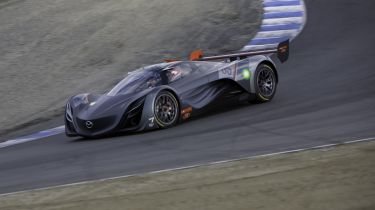Mazda Furai
Race-inspired two-seater swoops in - we strap in for a wild ride.
Can Mazda really build a Ferrari-rivalling mid-engined supercar for the road with the same ease as it has done for the track? Well, although you’re unlikely to see a Furai parked in the forecourt of your local showroom any time soon, one thing is certain – the manufacturer’s famous zoom-zoom mentality is clearly in top gear. And it will undoubtedly be applied to forthcoming sporty models that will share some of the visual drama of this amazing car.
Forget the Lexus LF-A Roadster, and turn your eyes away from the Audi R8 V12 TDI. The fastest, most extreme car to make its debut at this year’s Detroit Motor Show was produced by Mazda. And to prove it, the Japanese company invited Auto Express aboard for a very special ride.
We didn’t need asking twice. The first pictures of the sensational Furai (Issue 994) revealed what an incredible piece of design the car is. But as we found out, the wild lines are really only half the story.
Named after the Japanese phrase for “the sound of the wind”, the two-seat Furai was built by Mazda engineers from a list of dream parts. This included cutting-edge components and materials from the world of motorsport, and one of the most famous engines in the company’s history.
Used - available now

2021 Skoda
Enyaq
25,012 milesAutomaticElectric
Cash £18,500
2022 MG
HS
3,750 milesAutomaticPetrol1.5L
Cash £19,100
2021 Kia
Ceed
22,212 milesManualPetrol1.0L
Cash £13,000
2022 Kia
Sportage
26,692 milesAutomaticDiesel1.6L
Cash £23,000The team started with the chassis. Rather than adapting a road car platform, Mazda chose a carbon composite item built by French endurance racing firm Courage. This had previously been used to race in the American Le Mans Series (ALMS).
At nearly two metres wide and four metres long, the structure was also the perfect place to mount a very special 450bhp rotary engine. It was inspired by the same unit seen in Mazda’s own Le Mans 24 Hours-winning 787B race car, and was built using parts similar to those found in the roadgoing RX-8 coupé.
But there’s no preparing you for the results. In the metal, the car looks out of this world. The Furai packs a huge visual punch just standing still and, sitting only a metre high, you have to crouch down to see inside. Climbing aboard is tricky, too. Although the scissor doors open wide, the cockpit is snug to say the very least – especially for two occupants!
Behind the wheel, our chauffeur awaits. And after wriggling through the door, we are shoulder-to-shoulder with racer Jamie Bach, ALMS driver of the Courage that donated the chassis on which the Furai is based. There’s only time for a brief hello before we blast off.
As we pull away, the clutch is pressed once, which helps the engine engage the sequential gearbox’s first ratio. After this, changes are made by operating the steering wheel-mounted paddleshifters – and they come like gun shots as we race to the 9,000rpm red line. At low speeds, the engine sounds more like a helicopter at take-off than a highly tuned rotary powerplant. But as our pace builds, the gruff note turns into the high-pitched whine of a fighter jet engine.
Out on the test track, we hit 100mph before the first big corner. The carbon brakes are pressed and we drop down from fifth to second, peeling into a tight bend. Forces build to an amazing 2G as we fire back out on to the following straight and race up through the gears to a staggering 160mph. “The hardest thing is to get it going,” says Bach, “and the carbon brakes need getting used to; they bite nearly twice as hard as conventional steel items. But it’s a responsive, fast, and well balanced car to drive.”
It takes a minute to climb out, and as we do, we can’t help but wonder what the car – undoubtedly impressive on the track – would be like to drive on the road. That’s clearly a question Mazda has asked itself, too. As our test session comes to an end, it becomes obvious that there’s more to the Furai than looks and speed alone – those outrageous curves and advanced features are a strong hint about the company’s future models, too.
Rival: Lexus LF-A
With its carbon fibre body and 230mph top speed, Lexus’s LF-A is tipped to hit the road later this year, and will pip the Mazda to become Japan’s first truly modern mid-engined supercar. Its Ferrari-rivalling V10 engine has been developed by F1 experts, and is reckoned to offer more than 600bhp.







